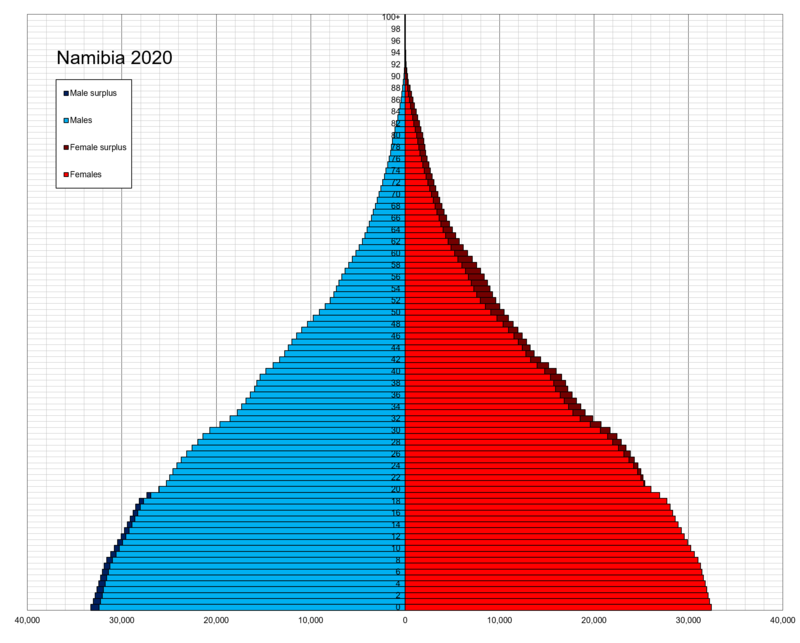Namibia, located in the southern region of Africa, is a country that has experienced significant demographic changes over the past few decades. One of the most insightful tools for understanding these shifts is the population pyramid, a graphical representation that showcases the age and gender distribution of a country’s population. By examining Namibia’s population pyramid, we can gain a deeper understanding of the country’s demographic trends, including its growth, age structure, fertility rates, and mortality patterns. These trends not only reflect the social, economic, and political conditions of Namibia but also highlight the challenges and opportunities that lie ahead.
In this article, we will take a closer look at Namibia’s population pyramid, its key demographic trends, and the challenges that the country faces in relation to population growth, age structure, and social development.
What is a Population Pyramid?
A population pyramid is a chart that shows the distribution of a population by age and gender. It typically consists of two horizontal bar graphs: one for males and one for females. The y-axis represents age groups (usually in five-year increments), while the x-axis shows the number of people or the percentage of the population in each age group. A population pyramid can reveal important insights into the growth rate, fertility rate, life expectancy, and potential future demographic changes of a country.
The shape of a population pyramid can provide clues about the economic development and social dynamics of a nation. A wide base with narrow upper sections typically indicates a high birth rate and a young population, while a narrow base suggests low birth rates and an aging population. By examining Namibia’s population pyramid, we can gain insight into the country’s current demographic profile and the challenges it may face in the future.
Key Trends in Namibia’s Population Pyramid
1. A Growing Population
Namibia’s population has experienced steady growth in recent decades. As of the 2021 Population and Housing Census, the country’s population stands at approximately 2.5 million people, with a growth rate of around 1.4% per year. This growth rate is relatively moderate, but it still represents a significant increase over the past few decades, with the population having doubled since independence in 1990.
The population pyramid of Namibia reflects this growth, with a substantial number of young people in the lower age groups. The country has a relatively high birth rate compared to many other nations in the region, and this is evident in the broad base of its population pyramid. The youth bulge is characteristic of Namibia’s demographic structure, which poses both opportunities and challenges for the country’s future development.
2. A Youthful Population
One of the most striking features of Namibia’s population pyramid is its young population. The lower age groups (0-14 years) represent a significant proportion of the overall population, making up around 35% of the total population. This youthfulness is a direct result of high fertility rates and a relatively low median age.
According to recent data, the median age of Namibia’s population is around 20 years, which is relatively young compared to many developed nations. This presents a unique set of opportunities for Namibia, particularly in terms of labor force expansion and potential economic growth. However, it also poses significant challenges, particularly in the areas of education, employment, and healthcare.
3. Declining Fertility Rates
Over the past few decades, Namibia has seen a decline in fertility rates, a trend that is common across much of the African continent as countries urbanize and develop. The total fertility rate in Namibia has decreased from 6.4 children per woman in the early 1990s to around 3.5 children per woman in recent years. This decline is due to a variety of factors, including increased access to family planning, education, and improved healthcare.
While the decline in fertility is a positive sign in terms of women’s empowerment and access to reproductive health services, it also means that Namibia’s population growth rate may begin to slow down in the coming decades. This could lead to a demographic transition, where the proportion of young people in the population gradually decreases, and the working-age population becomes a larger share of the total population.
4. Aging Population
Although Namibia’s population remains predominantly young, there are early signs of aging in the upper age groups. The proportion of people aged 65 and older has been steadily increasing, albeit at a slow pace. Currently, around 4% of Namibia’s population is over 65 years old, but this figure is expected to rise as life expectancy increases.
The aging population presents a set of challenges for Namibia, particularly in terms of healthcare, social services, and pension systems. As the population ages, there will be an increasing demand for healthcare services, especially for age-related conditions such as chronic diseases, disabilities, and geriatric care. Additionally, the dependency ratio (the ratio of dependents to the working-age population) will rise, putting further strain on social services and resources.
5. Gender Imbalance
Like many countries, Namibia has a gender imbalance in its population pyramid. There are more females than males in the older age groups, which is a common demographic trend due to higher life expectancy among women. Women in Namibia live, on average, several years longer than men, which results in a higher number of elderly women compared to elderly men. This is a reflection of the broader trend of gender disparities in life expectancy across sub-Saharan Africa, where women tend to live longer than men due to various factors, including maternal health, disease prevalence, and lifestyle.
While gender imbalances may not pose significant challenges in the short term, they may lead to challenges in areas such as caregiving and economic participation in the longer term.
Challenges Facing Namibia’s Population Pyramid
1. Education and Employment for a Growing Youth Population
Namibia’s youth bulge presents significant opportunities, but it also poses challenges, particularly in terms of education and employment. With a large percentage of the population still in school or entering the workforce, there is a pressing need to expand and improve the education system to meet the demand for skilled labor.
Moreover, the youth unemployment rate in Namibia is a growing concern. The government has worked to create job opportunities, but the demand for employment often exceeds the available opportunities, leading to high unemployment among young people. Skills development and vocational training will be essential in ensuring that the youth are equipped with the necessary skills to contribute to the economy.
2. Healthcare and Life Expectancy
While life expectancy in Namibia has increased significantly over the years (from 53 years in 1990 to 66 years in 2020), there are still challenges related to healthcare access and chronic diseases. The HIV/AIDS epidemic has had a profound impact on Namibia’s population, particularly in the 1990s and early 2000s. While HIV prevalence has decreased, the country still faces significant challenges related to healthcare infrastructure and disease prevention.
As the population ages, Namibia will need to address the growing demand for elderly care and improve healthcare services for the aging population.
3. Urbanization and Migration
Another significant demographic trend in Namibia is the increasing rate of urbanization. More people are moving from rural areas to cities in search of better employment and educational opportunities. This urban migration is placing pressure on urban infrastructure, housing, and social services in cities like Windhoek, Rundu, and Walvis Bay.
The growing urban population will require continued investments in housing, public transportation, healthcare facilities, and education. Additionally, there may be challenges related to rural depopulation as younger generations migrate to urban areas, leaving behind aging populations in rural communities.
Opportunities for Namibia’s Population Growth
Despite the challenges posed by demographic trends, Namibia also has significant opportunities as it moves forward. The country’s relatively young population represents a demographic dividend—a large workforce that can drive economic growth and development. By investing in education, skills development, and job creation, Namibia can harness this young population to propel its economy.
Additionally, Namibia has made significant progress in addressing gender equality, with more women participating in the workforce, education, and politics. This trend can contribute to a more inclusive and balanced development process, benefitting both men and women.
Namibia’s population pyramid is a powerful tool for understanding the country’s demographic trends, growth, and challenges. The youthful population, declining fertility rates, and signs of aging present a complex mix of opportunities and challenges for Namibia’s future. By addressing key issues such as education, employment, healthcare, and urbanization, Namibia can effectively manage its population growth and ensure a prosperous and sustainable future for all its citizens.
As Namibia continues to navigate its demographic transition, the government, civil society, and the private sector must work together to address the needs of its population and ensure that the country remains on a path of inclusive and sustainable development. The country’s success in leveraging its population trends will play a key role in shaping its future trajectory.
Join 'Namibia Today' WhatsApp Channel
Get the breaking news in Namibia — direct to your WhatsApp.
CLICK HERE TO JOIN











